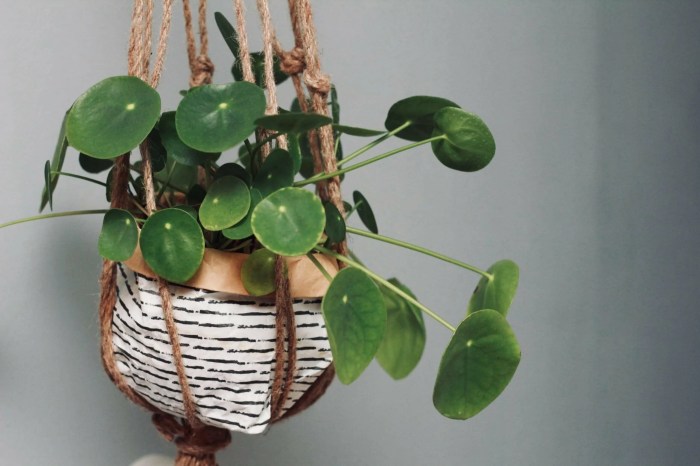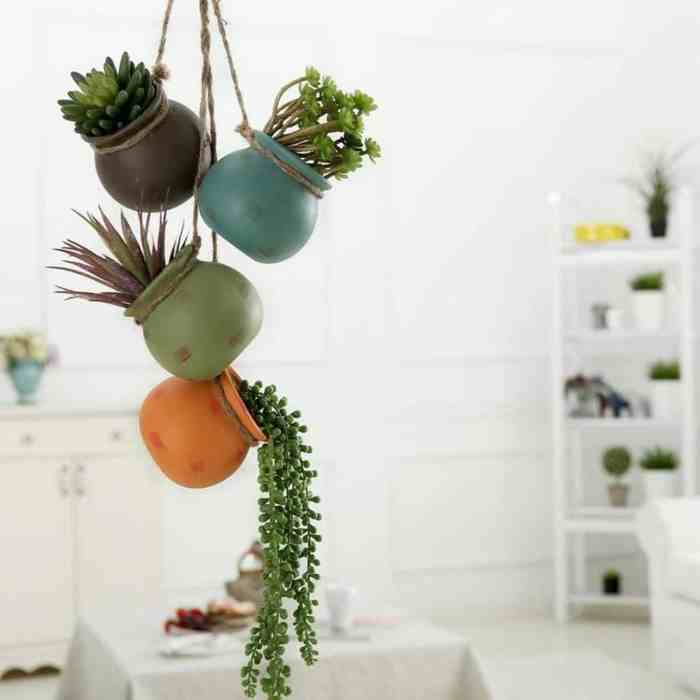Incorporating best indoor hanging plants into your living space offers a plethora of benefits, from improving air quality to adding visual interest. Discover the ideal plants for air purification, explore their aesthetic qualities, and learn expert tips for their care and maintenance.
With their cascading foliage, trailing vines, and vibrant colors, hanging plants create a captivating visual impact. Whether you prefer modern, bohemian, or farmhouse decor, there’s a hanging plant style to complement your aesthetic.
Best Indoor Hanging Plants for Air Purification

Indoor plants have gained recognition for their ability to enhance air quality by removing pollutants and improving oxygen levels. Several hanging plants are particularly effective at purifying the air, making them ideal for homes and offices.
Studies have shown that plants can absorb harmful chemicals like formaldehyde, benzene, and trichloroethylene, which are commonly found in household products and building materials. By placing air-purifying plants in strategic locations, you can create a healthier indoor environment.
Effective Air-Purifying Hanging Plants
- Spider Plant:This versatile plant is known for its ability to remove formaldehyde and xylene from the air.
- Snake Plant:The snake plant is effective at removing benzene, trichloroethylene, and formaldehyde, making it a great choice for bedrooms and living rooms.
- Peace Lily:This elegant plant absorbs formaldehyde, trichloroethylene, and ammonia, making it ideal for homes with pets or smokers.
- Golden Pothos:Golden pothos is a fast-growing vine that removes formaldehyde, xylene, and toluene from the air.
- Boston Fern:This lush fern is effective at removing formaldehyde and xylene, and it also adds humidity to the air.
Placement for Maximum Air Purification
To maximize air purification, place hanging plants in areas with good air circulation. This allows the plants to absorb pollutants more effectively. Consider hanging them near windows, doorways, or in the center of a room.
The number of plants needed for effective air purification depends on the size of the room and the level of pollution. As a general rule, one plant per 100 square feet is sufficient. However, for rooms with high levels of pollution, you may need to add more plants.
Aesthetic Appeal: Choosing Hanging Plants for Visual Impact

Hanging plants add a touch of elegance and greenery to any indoor space. With their cascading foliage, trailing vines, and vibrant colors, they create a visually stunning display that can enhance the ambiance of any room.
Cascading Foliage
- Spider plants:With their long, arching leaves, spider plants create a lush, cascading effect. They are easy to care for and can tolerate low light conditions.
- Ferns:Ferns, such as Boston ferns and maidenhair ferns, have delicate, feathery fronds that cascade beautifully. They prefer humid environments and indirect sunlight.
- String of hearts:This trailing plant has heart-shaped leaves that create a cascading curtain effect. It is a low-maintenance plant that thrives in bright, indirect light.
Trailing Vines
- Pothos:Pothos is a versatile plant with trailing vines that can reach several feet in length. Its heart-shaped leaves come in a variety of colors, including green, yellow, and white.
- Philodendron:Philodendrons have glossy, heart-shaped leaves that trail elegantly. They prefer bright, indirect light and well-drained soil.
- Hoya:Hoyas are succulent plants with trailing vines that produce clusters of fragrant flowers. They are relatively easy to care for and can tolerate low light conditions.
Vibrant Colors
- Coleus:Coleus plants have colorful, variegated leaves that come in a wide range of shades, including red, purple, green, and yellow.
- Hypoestes:Also known as polka dot plant, hypoestes has brightly colored leaves with contrasting spots or polka dots.
- Tradescantia:Tradescantia, or wandering jew, has trailing vines with vibrant green, purple, or variegated leaves.
To create a visually stunning hanging plant arrangement, consider combining plants with different leaf shapes, textures, and colors. Place them at varying heights to create a layered effect and use macrame hangers or other decorative containers to add a touch of style.
Care and Maintenance
Maintaining the health and beauty of hanging plants requires proper care and maintenance. Understanding their specific needs, such as watering, light, and humidity, is crucial for their thriving growth.
Regular watering is essential, but overwatering should be avoided. The frequency of watering varies depending on the plant species, pot size, and environmental conditions. A good rule of thumb is to allow the soil to dry out slightly between waterings.
Watering Techniques
- Check the soil moisture regularly by inserting a finger into the soil.
- Water thoroughly when the soil feels dry to the touch.
- Avoid using cold water, as it can shock the plant’s roots.
- Water slowly and evenly, allowing the water to soak into the soil.
- Avoid getting water on the leaves, as it can promote disease.
Fertilization
Fertilizing hanging plants every few weeks during the growing season promotes healthy growth and flowering. Use a balanced liquid fertilizer diluted to half strength.
Common Pests and Diseases
Hanging plants are susceptible to common pests and diseases, such as aphids, mealybugs, and powdery mildew. Regular inspection and early detection are key to preventing and treating these issues.
Insecticidal soap or neem oil can be used to control pests. For diseases, isolate affected plants and remove infected leaves. Maintaining proper watering and humidity levels can also help prevent disease outbreaks.
Design Considerations: Best Indoor Hanging Plants

Integrating hanging plants into home decor not only purifies the air but also enhances the aesthetic appeal of a space. Various hanging plant styles and decorative elements complement different decor themes, creating a harmonious and visually captivating environment.
Hanging Plant Styles for Decor Themes
The following table compares popular hanging plant styles with their suitability for various decor themes:
| Hanging Plant Style | Suitable Decor Themes |
|---|---|
| Trailing Plants (e.g., Pothos, String of Pearls) | Modern, Bohemian, Farmhouse |
| Cascading Plants (e.g., Philodendron, Spider Plant) | Bohemian, Eclectic, Tropical |
| Upright Plants (e.g., Snake Plant, ZZ Plant) | Modern, Minimalist, Scandinavian |
| Epiphytic Plants (e.g., Orchids, Air Plants) | Bohemian, Eclectic, Tropical |
Incorporating Hanging Plants into Different Rooms
Hanging plants can transform the ambiance of various rooms in the house:
- Living Rooms:Large trailing plants suspended from the ceiling or cascading from shelves create a lush and inviting atmosphere.
- Bedrooms:Smaller hanging plants with air-purifying qualities, such as spider plants or peace lilies, promote relaxation and improve air quality.
- Kitchens:Herbs and small succulents hung near windows provide a touch of greenery and freshness while adding a practical element.
Decorative Elements for Hanging Plants, Best indoor hanging plants
In addition to plant styles, decorative elements enhance the visual impact of hanging plants:
- Macrame Hangers:Intricate macrame hangers add a bohemian or eclectic touch to hanging plants.
- Plant Stands:Metal or wooden plant stands elevate hanging plants to create a focal point or display multiple plants together.
- Ceiling Hooks:Ceiling hooks allow for flexible placement of hanging plants, creating a canopy effect or cascading down walls.
By carefully considering hanging plant styles, incorporating them into different rooms, and using decorative elements, homeowners can create visually stunning and air-purifying indoor spaces.
Unusual and Trending Hanging Plants
Step away from the familiar and embrace the unconventional with unique and trending hanging plants. These lesser-known gems add a touch of individuality to indoor spaces, sparking conversations and inspiring awe.
The latest trends in hanging plant varieties reflect a growing appreciation for diversity and sustainability. From the dramatic foliage of the String of Hearts to the ethereal beauty of the Air Plant, these plants are gaining popularity for their aesthetic appeal and ease of care.
Sourcing and Care
Sourcing these unconventional plants may require a bit of exploration. Check local nurseries, plant shows, and online retailers specializing in rare and exotic varieties. Once you’ve found your perfect plant, provide it with the appropriate care to ensure its well-being.
Discover the allure of indoor hanging plants, adding a touch of nature’s embrace to your living spaces. Explore Plants for a comprehensive guide on choosing the perfect hanging plants for your home. These verdant wonders not only beautify your surroundings but also purify the air, creating a harmonious and rejuvenating atmosphere.
- Research the specific light, water, and humidity requirements of your chosen plant.
- Use well-draining soil and provide proper drainage to prevent root rot.
- Fertilize regularly during the growing season to support healthy growth.
Closing Summary
From air-purifying wonders to unique and trending varieties, best indoor hanging plants transform your home into a verdant oasis. Embrace the beauty and benefits of these captivating plants, and create a thriving indoor ecosystem that enhances your well-being and adds a touch of natural elegance to your space.
Essential FAQs
What are the best hanging plants for air purification?
Spider plants, peace lilies, and snake plants are highly effective at removing pollutants from the air.
How often should I water my hanging plants?
Water when the top inch of soil feels dry to the touch. Overwatering can be detrimental.
What are some common pests that affect hanging plants?
Aphids, mealybugs, and spider mites are common pests. Regular inspection and prompt treatment are essential.